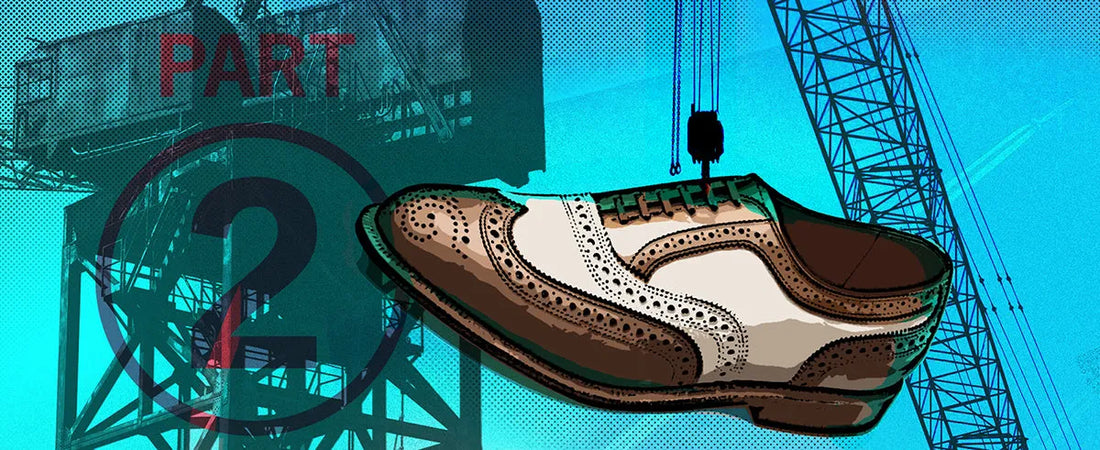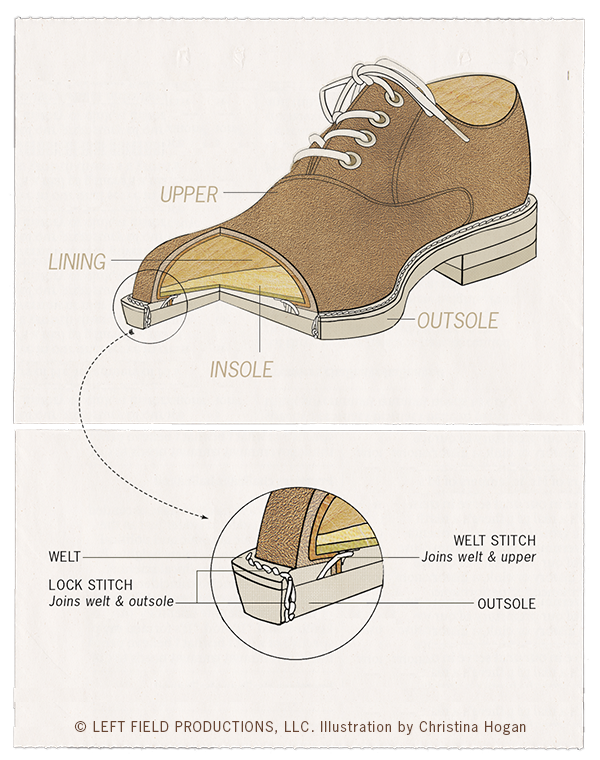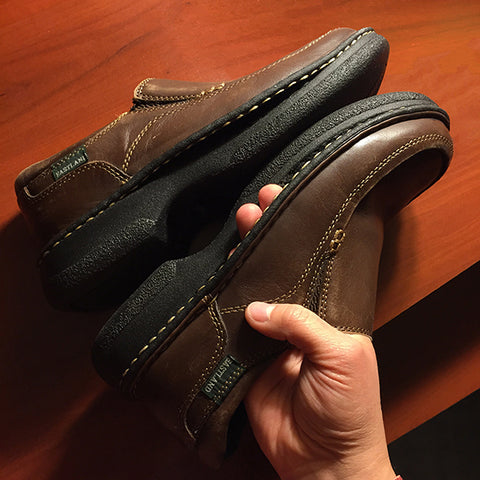
Sustainable Shoes: Part 2 – How are my Shoes Made?
Share
What should you look for if you want to buy footwear that, with proper care, will last for many years? Here is some basic information regarding sustainable footwear.
Sustainability has two components: what shoes are made of and how they are made. Part 1 includes information to help you determine what materials your shoes are made of. Next let’s talk about the combinations of materials and construction methods that, in my opinion, create the most long-lasting footwear.
The wide varieties of material and construction methods available today make it possible for most people to own multiple pairs of footwear. It’s likely that not all of your footwear is made of the same materials or made in the same way. The type of shoe you buy will in large part depend on how you plan to use it. You’re probably not going to hike in a dress shoe, and you’re probably not going to dance in a hiking boot.
I see and repair dozens of shoes each week. My experience tells me that there is not one particular material or construction method that is “best” for everybody and for every purpose. Therefore I’ve developed a sort of hierarchy of what to look for when you are trying to buy sustainable footwear. I present this hierarchy as “here’s the rule, but here’s the exception.”
Main guiding principle:
Good Materials + Quality Construction = Good Shoes
This seems obvious, but what does it really mean? This is where my hierarchy comes in. I’m going to lay down my basic “rules” and then sift through the exceptions to come to some conclusions.
As noted in Part 1, when looking for sustainable footwear it’s best to focus your attention on four major areas:
- The upper – The exterior portion of your footwear that is not the sole. In my experience, sometimes the shaft of a boot is not included in this definition and may be a different material.
- The lining – this is the part of the shoe that is on the inside of the upper. It touches your skin (or your socks).
- The welt – this is the part of a shoe that holds the upper to the sole. Not all shoes have a welt.
- The sole - this is the part of the shoe that touches the ground. Sometimes called the “outsole.”
What to look for in shoes when it comes to sustainable:
+ Upper
General Rule
Leather lasts longer than fabric or man-made materials
Exceptions:
Poor quality Leather - leather is a great material for shoes and boots and will usually outlast most other materials. But as we noted in our Field Guide, not all leather is the same. Do some checking about what type of leather you’re getting. Unfortunately, price is not always a good indicator of quality.
Constant wet/dry - leather is not always the best option for certain kinds of conditions. If you’re getting your shoes or boots wet and muddy on a daily basis, they may not last as long as you’d hoped. The mud-moisture-dry cycle can act almost like a saw across the flexing parts of the footwear. Deep and jagged cracks can develop and shorten the life of the footwear.
If you like the feel and fit of leather, but you work or play in a continuously wet and muddy environment it’s best if you can either protect them with an overshoe or be serious about letting them dry out, cleaning the mud off, and then routinely applying a conditioner and waterproofer.
Vegan footwear – I have seen shoes and boots specifically made as vegan footwear that is among the most well-made footwear I’ve come across. The price of this footwear is typically reflective of this superior quality. If you are selecting vinyl footwear because you do not want to use leather, you may want to be sure the highest quality materials and construction methods are being used to ensure longer life of your footwear.
+ Lining
General Rules
A leather lining is best
Fabric is better than vinyl
Exceptions:
Wet Conditions - I actually think a leather lining is best. Leather linings tend to hold up really well. But again, if your footwear is getting wet on a regular basis, a synthetic fabric lining is probably better than leather.
Oftentimes I see a nice leather upper lined with vinyl. The vinyl cracks over time and crumbles away from its backing. It looks and feels terrible. This is an area that you want to be careful about when checking what your shoes are made of. Really check the manufacturer’s details. Sometimes you will read “fully lined leather upper.” This doesn’t necessarily mean the lining is leather.
+ Welt
General Rules
A welt is better than no welt
A stitched welt is better than a cemented welt
A leather welt is better than a rubber or plastic welt
If no welt, look for a midsole

Welt - details of how a welt is attached.
When I refer to a welt I am referring to a separate strip of leather, rubber or plastic that is stitched or cemented to the upper to which the sole is then attached. A welt can be stitched or cemented to the upper and the sole.
Another very strong method for constructing shoes is the Blake (or McKay) stitched method. This method results in a slimmer appearance because the sole is stitched directly to the upper from the inside of the shoe.
A midsole is a full-length outer sole which is usually glued to the upper and then stitched either directly to the upper or to the welt. This is also a very good method for constructing footwear. The sole is then cemented and/or stitched to the midsole. The Blake stitch and midsole construction methods are a bit less likely than a welt to keep water from reaching the interior of the shoe.
A large amount of information about welts and shoe construction methods is available on the web. I do not explore the fine points of those construction methods in this article. My goal is to discuss what types of shoes are most repairable/sustainable.
After many years of repairing all types of footwear, I conclude that a welt, any welt, is better than no welt if you’re concerned about re-soling. A shoe made with a welt can usually withstand multiple resoles. In addition, worn or broken leather welts can be easily replaced by most cobblers. Many manufacturers offer re-crafting services for welted footwear. This service oftentimes includes replacing the welt. Any time you can replace the original parts, you are talking sustainability.
A lot of quality footwear is made with a welt and a midsole (suspenders and a belt, ha ha). I love this construction method. It makes re-soling very straightforward and provides many options with respect to replacement soles.
 Leather welted boot with new soles and heels
Leather welted boot with new soles and heels
A cemented welt is not as strong as a stitched welt. But most cemented leather welts can be re-cemented when they come apart and can be replaced when they crack or break.
Leather welts tend to last longer than plastic and rubber welts. Plastic welts are prone to cracking at the stress points which can cause severe leaking.
Exceptions:
Although welts are preferable, many types of unwelted footwear are well-made and very sustainable. Here are some examples:
Cemented Components – Birkenstock sandals with a leather upper, cork footbed and EVA sole are among the most sustainable footwear on the market. Every piece of these sandals can be either repaired or replaced. I wish I had invented them. Many types of fine men’s and women’s dress footwear are totally cemented together. Today’s adhesives are pretty amazing. Many of these shoes and boots can be resoled.
Cemented “unit” type soles – Many hiking boots are made with soles that are cemented to the upper. No welt, no stitching of any kind holding the parts together. So long as the boot is made with a full-length lasting board, these soles can be replaced. Stitchdown or turnout shoe – these shoes and boots look like they have a welt, but they don’t. Good examples of turnout shoes can be seen at conkershoes.com. This is a simple and good way to make a shoe or boot. Danner, Clarks and many other makers of quality shoes and boots use this method on some of their footwear.
Stitchdown shoes can usually be resoled if they are stitched to a midsole. If they are stitched directly to a molded sole, it’s unlikely they can be resoled.
+ Sole (Outsole)
General Rules
Leather Soles are comfy, long lasting and can be dressed up or down
“Rubber” Soles are comfy, long lasting, formal or casual
Polyurethane (PU or PUR) Soles = Caution!
Natural Gum Rubber or Plantation Crepe Soles = Caution!
One-Piece Molded Soles = Caution!
Leather soles are extremely comfortable, but will require a breaking in period. They last a long time and can usually be replaced as long as the upper is in good shape. Their tendency to be rather slippery can be remedied by adding a thin rubber outsole over the leather. This thin rubber sole is sometimes known as “cat’s paw,” sole guard, or sole saver. If applied correctly it will preserve the beauty and comfort of the original leather sole while adding grip and protection. When the rubber sole guard wears out it can be removed and replaced without having to disturb the original leather sole.
What we call “rubber” soles today are often a compound of rubber and plastic. Many different materials exist today to meet different demands for durability, abrasion resistance, weight, and comfort depending on the application. You can find rubber soles on everything from dress shoes to lineman’s boots. They perform well; and many can be replaced with high-quality, readily-available replacement soles. Rubber soles win the longevity battle in my opinion, but leather wins on comfort.
Exceptions:
Let me explain why you should be cautious about the last three materials on my list.
Polyurethane Soles - polyurethane is a plastic material which can exist in many forms-some flexible, some rigid. The reason for caution is because soles made of polyurethane will eventually break down, crack, and crumble. This process is a function of the age of the soling material. Usually this process of breaking down begins somewhere around the 5-7 year point.
I have customers nearly every week who bring in shoes with pristine uppers and crumbling PUR soles. I used to just remove the cracked or crumbling part of the sole, if possible, and bond a new sole to the remaining PUR sole. But the original PUR sole will eventually deteriorate and the bond holding the new sole will fail. In my opinion, that’s not a good value for my customer. If the shoes don’t have a midsole or a welt – I can’t repair them.
Regular and hard wear of PUR soles will actually postpone the deterioration process. I usually tell people who have PUR soles to just wear the heck out of them because the soles won’t last forever and they can’t be resoled if they don’t have a midsole or welt.
Natural Gum Rubber Soles – natural gum rubber, also called plantation crepe, is natural latex from rubber trees that has been coagulated usually into rather coarse-looking sheets that can be used for shoe soling, among other things. The reason I advise caution is that this soling will begin to soften and become very sticky if it comes into contact with any sort of petroleum product. Be careful when pumping gas, or standing at the bus stop, or walking across the street! I once had a customer whose shoes became stuck to his closet floor when his plantation crepe soles got real sticky after he pumped gas. It also can be very slippery in wet and cold weather.
Natural gum rubber (plantation crepe) which undergoes further processing becomes “regular” rubber and is used for all sorts of products, including shoe soles. Rubber shoe soles (also called caoutchouc) do not have the same “negative” qualities as noted above.
A few words about “crepe:” In the shoe industry, Ethylene Vinyl Acetate (EVA) is also called “crepe.” This may create some confusion with plantation crepe. They are not the same thing. EVA is a man-made material (the copolymer of ethylene and vinyl acetate). Plantation crepe is a natural product from rubber trees. EVA is an extremely flexible material with properties similar to rubber but with excellent toughness. Many shoes are made with EVA soles or with EVA as a mid layer and a tough rubber compound material for the outermost sole. It has neither the disintegration qualities of PUR nor the “sticky” qualities of plantation crepe.
One-Piece Molded Soles – these soles usually come in one of two types:
- Molded soles that are stitched to the upper. These shoes are often made to look like they have a separate welt, but they don’t. The soles are one molded piece of polyurethane or other material and the stitch holes are molded into the sole. The sole is then stitched to the upper through these holes. The stitching is real, but the welt is not. If the holes wear through or break, the shoe is usually a total loss.
The sole can’t be restitched or replaced except with an original sole from the manufacturer. Many manufacturers change models quite frequently and the soles are often not available. This type of shoe causes more heartbreak for my customers than any other type of shoe.
 Pristine upper with molded PUR sole that can't be repaired.
Pristine upper with molded PUR sole that can't be repaired.
- Soles bonded directly to the upper with a pseudo-welt which comes up onto the upper and forms a little “cup” that hugs the upper. These pseudo-welts will often have stitching molded right into the soling material to make it look like the sole is stitched. Sometimes the sole will even have molded stitches or real thread on the bottom to make it look like the soles are stitched. They are not stitched, but it gives you an idea about how valuable stitched soles are if manufacturers will go to these lengths to “fake” it.
The reasons for caution with this type of sole are two-fold. First, many, many molded soles are polyurethane (PUR) and we discussed above the problems with these soles eventually disintegrating. If the soles crumble, they can’t be replaced. Second, even if the sole is not PUR and it lasts long enough to simply wear out, it oftentimes cannot be replaced. It would be great if manufacturers made the molded and stitched soles available so that cobblers could replace them. But they typically do not. Many molded soles which may at first appear to have a stitched sole (with re-sole potential) may not be sustainable after all.
Conclusion:
If you sift through all my rules and exceptions you could put some things together to come up with a sustainable shoe. It might look something like this:
Leather upper, leather lining, welt construction, leather sole with rubber protection to meet the pavement. And you’d be about right. That is a very sustainable design.
Except, most of us have varied lives. We walk to work, we go to the beach, we walk in the water, we hike, we work in the garden, we go to the gym, and we go to weddings and funerals. And most of us need a variety of shoes to take us through our lives.
Your shoes have to fit your lifestyle and your budget. My hope is that by learning about some of the benefits and limitations of common materials and construction methods you may be able to find a type of shoe that is a bit more sustainable than some you have worn in the past. Even if you can’t afford the most expensive shoe on the market, you will know what to expect from the shoes you’re buying.
Continue this topic - Sustainable Shoes Part 1: – What are my shoes made of?
